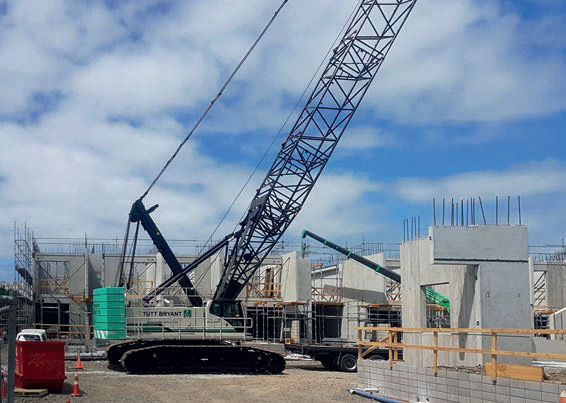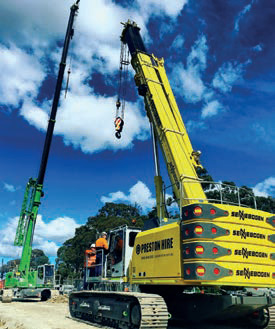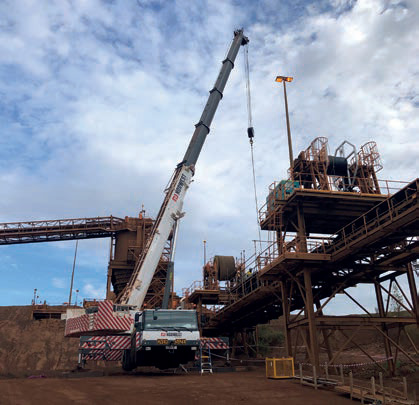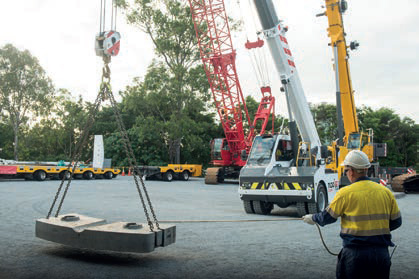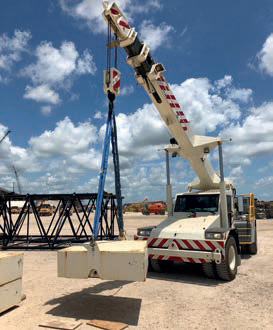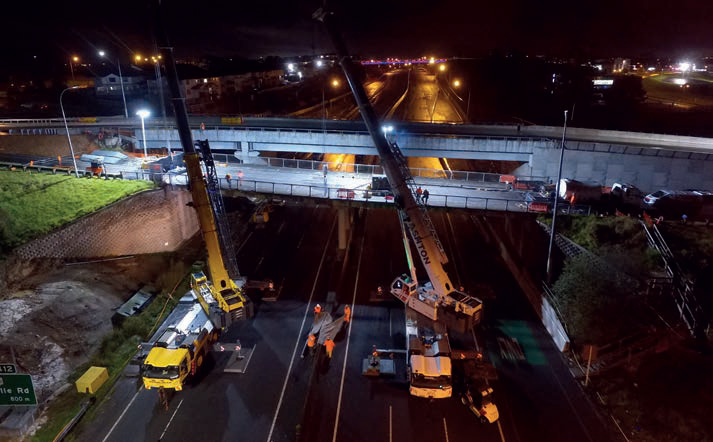Booming market
4 December 2020The mobile crane market in Australia and New Zealand performed well in 2020, despite the direct and indirect effects of the pandemic. In the case of Australia, the government has played a key role. Sotiris Kanaris reports.
The success of the Australian and New Zealand governments’ policies in containing and managing Covid-19 outbreaks has been widely covered by international media. Until the spread of the virus was controlled, these governments enforced strict measures, which had an impact on the crane market.
New Zealand-headquartered Tidd Ross Todd (TRT) manufactures the TIDD pick and carry cranes. Its director of sales and innovation Bruce Carden talks about the effect of the measures: “As a manufacturing company, we were directly affected by the initial seven week full lockdowns in New Zealand: forward orders were delayed and some cancelled across all manufactured products.”
He added that at the height of the pandemic in April and May, New Zealand-based travel restrictions also caused delays in major infrastructure projects that are run by large Australia-based contractors, who were unable to get all of their Australia-based staff back onsite.
The movement of staff was an issue in Australia as well when local restrictions were enforced.
“Because of the restrictions that hit Melbourne the market has been slow, with projects finding it hard to commence. It has created massive logistical difficulties for a national business like ours. Border restrictions have meant we have had to re-jig our staffing and who can cover which projects,” says Rob West, senior divisional manager at Tutt Bryant Heavy Lift & Shift.
Anthony Heeks, managing director at Pace Cranes— distributor of Sennebogen, Maeda and Manitex Valla—says they also had difficulties sending staff interstate because state borders were closed. He added that because of the pandemic they experienced some issues with deliveries of cranes in container vessels.
However the impact on business has not been large. “We navigated through the Covid-19 virus relatively unscathed. Fortunately we had a strong forward order book and mobile crane deliveries on Ro-Ro vessels were not too affected,” says Heeks.
“Through the initial onset, we saw the market stall, but recover to be back to at least 80% of forecasted business for 2020,” says managing director at Tadano Oceania Anthony Grosser.
Apart from the effectiveness of its policies that allowed the economy to restart fairly quickly, the Australian government’s investments in infrastructure also had a positive effect on the crane market.
Big Spender
“The Australian Government had invested heavily in local infrastructure projects in the previous three years so we had many projects up and running and most companies in the construction sector were able to continue working,” says Heeks.
The investment in infrastructure is going to continue. “The government has stated that construction in Australia will be the road to recovery for our economy and the government has added many new projects and brought forward many others which include bridges, railways and harbours, followed by electricity and pipelines,” Heeks explains.
Another positive effect of the Australian government’s policies on the crane market was its support of renewable energy sources, which led to the boom in the wind energy market and hence increased demand for lifting solutions.
Andrew Esquilant, general manager of the mobile crane and crawler crane division at Liebherr Australia, says there are a number of projects across the country, but predominantly in the East Coast. He adds that the local mining sector has also been driving demand for mobile cranes, following a recovery in the coal and iron ore industries.
Analysing the past six months, Tadano’s Grosser says: “Over the past six months we have seen highs and lows across all markets.
Queensland and Western Australia have been the big drivers due to the mining and construction projects in place, though Victoria and South Australia are also seeing some quick returns to the market.
We have seen investment at every level of the market which is very positive in the current climate.”
At Tadano they find that the market has various requirements and they are “experiencing success” in all facets of the range. “Given we supply seven product ranges from 2t to 3,200t, it is reassuring that we are seeing a good spread across the range.”
Out of the newest Tadano and Demag products across all the lines, Grosser picks three all terrain models as the most successful commercially. “The Demag AC 300 would be our flagship model; it is class leading across many facets and we have seen strong growth in this range. The ATF-120-5.1 has seen strong interest early with the first unit sent straight to work within weeks of arriving and we are seeing this with the AC 60 as well.”
With more projects coming online and larger projects in infrastructure, TRT— Manitowoc dealer in New Zealand and for the Australian state of Queensland— has seen increased demand for Grove all terrain cranes, especially the new Grove GMK5250-XL.
Carden says the most popular model in Australia is the 150t Grove GMK5150-L.
“The new 50t Grove GMK3050- 2, which is designed for a single operator to manage set up and lift is proving to be a primary consideration in New Zealand.
Porter Hire was the first in Australasia to integrate this crane into its New Zealand fleet,” Carden says. “In New Zealand, there have been a number of changes in the market creating opportunity with larger capacity Grove models.
We have recently sold a Grove GMK5250L to Nikau Group and Grove GMK5250XL-1 to Ashton Crane Hire. What we have also seen is that these two cranes have been operating in the Auckland area together, completing several large double lifts on infrastructure projects.”
Liebherr launching new models and technological innovations has helped with growing its business in these two countries, according to Esquilant.
“The LTM 1060 is the most common day to day crane that we sell, along with the 1090-4.2,” he says. He adds that the LTM 1130-5.1 has also performed well in these markets; a model that Liebherr has recently replaced with the newly-launched LTM 1150-5.3.
Among the new models, Esquilant finds the LTM 1120-4.1 and also LTM 1650-8.1 well suited for the Australian and New Zealand markets. He says that they have already secured orders for the LTM 1120-4.1.
“We recently started to deliver our new rough terrain cranes which were well received by our customers. Predominantly these machines are used in mining in Australia, in Queensland and Western Australia,” Esquilant says.
Tadano has designed and manufactured two rough terrain models especially for the Oceania region, the GR-130EX and GR-200EX, which comply with Australian Standard and road regulation.
The latest model is the GR- 200EX, launched in 2018. “The GR-200EX has been a great success for the Oceania region and has been accepted well into all markets. Its compact design with 35m maximum boom length is perfect for the housing industry.
Radio remote setup and Tadano view safety camera systems are all part of the features that sets this machine apart from the rest,” says Grosser.
“The full range of rough terrain machines are constantly evolving and developing. This year we release a renewed product line up: Next Generation RTs. Our RT range covers from 13t to 145t and these machines are the backbone of the mining and construction industry in Australia.”
Crawlers
“As we only deal with the 400t and above, the market in Australia is limited, but for the first time in a very long time we are seeing local investment in the larger crawler cranes. In the past months we have received orders for our Demag CC3800-1 in varied configurations to support renewable energy projects and also large infrastructure projects,” Grosser says.
Tutt Bryant’s West talks about an explosion in demand for 400t–750t cranes, especially narrow track cranes, for the wind energy market. Analysing the crawler crane market for the past two years, he says: “The market has been steady and as ever in Australia it is variable by region.
Western Australia has been very busy. The East Coast is much more patchy, with strong Sydney demand now dropping and with Melbourne improving.”
Tutt Bryant is the distributor of Sumitomo Heavy Industries Construction Cranes (HSC). West says the SCX2800-2 (275t) has been the most popular. He adds that the new 100t SCX1000A-3 with its ability to run 70, 80, 90t load charts with counterweight reduction has also been popular.
TRT has been offering Manitowoc crawler cranes in New Zealand and Queensland for years. Earlier this year, it expanded its crawler crane offering by becoming the Kobelco distributor for both countries.
Carden says: “Manitowoc had announced a change in their crawler manufacture in the USA, leaving a gap in both New Zealand and Australia, especially for smaller capacity crawlers’ solutions where there are higher numbers in demand. Kobelco crawler cranes range complements our Manitowoc range.”
TRT will be delivering two Kobelco TK750G-FS telescopic boom crawlers in the first quarter of 2021 to Fulton Hogan and Dave Carr Plant Hire for use in construction and infrastructure.
TRT recently appointed Baden Davis Crane Connection (Crane Connection) as a Kobelco subdistributor for New South Wales and Australian Capital Territory. As to whether they are considering appointing more subdistributors, Carden said: “There are no plans at this time, but we may consider this opportunity in the future, but only if it is the right action for our customers and the right partner for TRT. We will always manage product imports and will continue to manage Kobelco crawler crane distribution, parts and service across the rest of Australia for the time being.”
Talking about the lattice boom crawler crane market, Pace Crane’s Heeks says it has been quite quiet for them. “We find it very competitive. This market is predominantly around the 100t to 300t class with some larger units around 500–600t capacity being imported.”
Conversely, the company has been very busy with the demand for its telecrawlers. “The telecrawler market has been very strong especially with cranes from 15t to 130t capacities. Many sales in the smaller end are for end users such as civil, piling and foundation companies,” Heeks says.
“We are now seeing the crane hire companies entering the telecrawler crane market with the larger capacity cranes such as 100t and above, and are looking for longer booms which are suited to general construction applications. These customers are familiar with longer boom all terrain cranes.” The most popular Sennebogen telecrawlers in the two countries are the 16t 613E and 40t 643E. At Pace Cranes they are seeing a growing interest in the new new Sennebogen 130t 6113E.
Apart from focusing on telecrawlers, the company also focuses on duty cycle cranes. “We have sold quite a few smaller 30t lattice boom duty cycle cranes, which are being used for barge applications which utilise grabs and crane hooks,” Heeks says.
Pick and carry cranes
Apart from indirectly boosting the crane market with infrastructure spending, the Australian government is directly helping the market through the Australia’s Modern Manufacturing Strategy.
Through the strategy, the Government says that approximately $1.5bn in new funding will be invested over the next four years to make Australian manufacturers more competitive, resilient and able to scale-up to take on the world.
Australian pick and carry manufacturer Franna, part of Terex, has a long history, being founded in 1978 by Dave Francis. Danny Black, general manager at Terex Cranes Australia and New Zealand comments: “Through this strategy, the government has expressed the importance of Australian manufacturers taking their expertise worldwide.
“Franna represents roughly half of the total mobile crane population in Australia, that is any rubber tyred crane of any capacity—truck crane, rough terrain crane and all terrain crane. Yet globally we are less than 1% of this same market, hence like the Australian government, we are keen to take our quality products globally. Franna has already embarked on this journey, expanding in Asia and Africa regions and entering new markets such as North America.”
In fact, a left hand drive version of their AT 22 model, the first of its kind in North America, was on display at this year’s ConExpo in Las Vegas. After the show, the crane made its way to work at a large LNG project in southern USA. Earlier this year, Franna’s local dealer in Mongolia MSM Group delivered three MAC 25-4 pick and carry cranes to local mine OyuTolgoi, one of the largest underground mines in the world in terms of gold and copper deposits. With the addition of these cranes, there are now a total of eight Franna pick and carry cranes working at the mine. Another Asian country where Franna cranes have been sold is Indonesia, through local Franna dealer PT. Berlian Cranserco Indonesia.
Franna offers four models, with lift capacities ranging from 15t to 40t. Its latest model is the 40t AT 40.
TRT manufactures two pick and carry models, the 25t TIDD PC25 and the 28t TIDD PC28. The latter was launched last year and Carden says the market has responded very positively to it.
As to the reason behind the choice of capacity, Carden says: “25–30t roadable lift solutions, like pick and carry cranes, have always been in demand on both sides of the Tasman. However, pick and carry fleets are getting older, especially in Australia and, unfortunately, it seems rollovers are more common as operators push lift charts to their limits.
“Everyone wants to be able to lift more with the available capacity of any crane and at a similar price point. With the TIDD PC28, it’s about balance of capacity, safety and function that the industry has demanded.
“Our goal was to create a better lifter, but to achieve this with a crane that is compact (2.5m wide) and more manoeuvrable. An example of how we are helping with cost efficiency is the reduction in the width of the PC28, not only is it able to operate within more restricted spaces—with the tightest turning circle in its class, there are no IAP or permits required to travel from site to site in some States, reducing operation costs and red tape delays.”
The manufacturer has focused on safety when developing the TIDD PC28. It has the certified ROPs and FOPs cab; TRT’s patented Slew Safe; and Traction Air, TRT’s tyre pressure control management system that maintains consistent 130 PSI.
Slew Safe was designed to prevent rollovers. It works with several features including audible alarms, LMI warnings and power steering that is restricted to 15% to prevent further slewing and yet full power in the safe direction.
“Accidents and incidents have been a key factor in demand. The increased number of PCBUs (a person conducting a business or undertaking) being prosecuted successfully in Australia and New Zealand has made this issue real for many owners,” Carden explains.
“As with any industry that has low levels of competition, there is a high level of complacency; this has been the case with pick and carry safety design from the past. The TIDD PC28 is supporting these industry-wide issues with fresh thinking around ensuring people are going home safe.”
Carden says that initially the TIDD PC28 was very popular for wet and dry hire companies, like MAX Cranes in South Australia and AM Cranes in the Northern Territory, across a variety of applications from construction to mining and resources. While this remains the same, the manufacturer says, there has been a surge in applications across the resources sector, especially in Western Australia.
A race against time
NRW Contracting commissioned Sarens to perform the crucial lift of rail bridge girders over operating railway track for Fortescue Metals Group’s Eliwana Project in the Pilbara, Western Australia.
The entire operation of transporting two girders from the laydown area to the lifting location and installation had to be completed during the 8-hour rail shut down window.
For the installation, Sarens mobilised a 650t Demag CC3800-1 lattice boom crawler crane. The crane was imported and mobilised to the site in three weeks and assembled in five days. Other equipment used during the project included: a Liebherr LTM 1150, two six-axle line SPMTs and two PPUs.
Two girders weighing up to 155t were transported from the laydown area to the lifting position and lifted at a radius of up to 42m. The entire operation was safely completed by a crew of eight members.
Big in Australia
Anthony Heeks, managing director at Pace Cranes, says there has been a steady growth in demand for mini cranes in Australia over the past 15 years, and that last year they sold most Maeda cranes since becoming the dealer in 1992.
Heeks talked about the variety of applications Maeda machines are used for: “The spider style is predominantly used in confined space applications. The MC285C is very popular in high-rise construction carrying out glass and curtain wall installations. This model fits into material hoist giving the owners great flexibility and access without relying on the site tower cranes.
“The CC models (small telecrawlers) are used in confined sites and have a small foot print and pick and carry capabilities. They are ideal for underground and tunnel works.”
The mini cranes market was positively influenced by the local government policies. The government has implemented tax incentives with 100% tax write off for equipment purchases up to AUS$150,000 before the ending of the fiscal year. “This encouraged purchases on our smaller Maeda cranes,” said Heeks.
The most popular machines in Australia are the 2.85t MC285C and 3t MC305C spider cranes.
